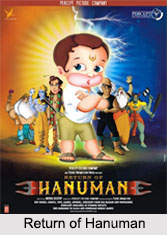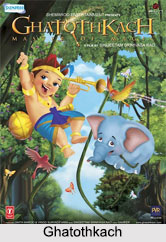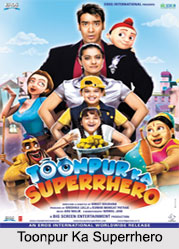 Animation Films are in vogue today and a fairly new concept in Indian Cinema. Whether it is a 2D or a 3D animation, it has an entertaining appeal on the audiences. Such films cater to audience of all ages. Thus, the popularity of this genre has prompted established entertainment production houses to invest in it. Mostly, the subjects of animation films made in India are based on Hindu Mythology. It is simpler to narrate interestingly a known tale than introducing a new one with new characters to the audience. Moreover, in a society where grandmother`s tales are being fast replaced by video games and smart phone games, animation films are a better and welcome way of familiarizing children with Indian mythology and Indian epics like Mahabharata and Ramayana, sections of which are very entertainingly depicted in these films.
Animation Films are in vogue today and a fairly new concept in Indian Cinema. Whether it is a 2D or a 3D animation, it has an entertaining appeal on the audiences. Such films cater to audience of all ages. Thus, the popularity of this genre has prompted established entertainment production houses to invest in it. Mostly, the subjects of animation films made in India are based on Hindu Mythology. It is simpler to narrate interestingly a known tale than introducing a new one with new characters to the audience. Moreover, in a society where grandmother`s tales are being fast replaced by video games and smart phone games, animation films are a better and welcome way of familiarizing children with Indian mythology and Indian epics like Mahabharata and Ramayana, sections of which are very entertainingly depicted in these films.
History of Animation Films
The first Indian animated film to be made was "The Banyan Deer", which was released in 1957 by Films Division of India, belonging to the Ministry of Information and Broadcasting, Government of India. Films Division had invited Disney Studios animator Clair Weeks, to establish and train the country`s first animation studio as part of the American technical co-operation mission. The core group of Indian animators trained by him brought out "The Banyan Deer". "Ek Anek Aur Ekta", a short educational film based on the values of unity, was another landmark animated film produced by Films Division of India. It was broadcast on Doordarshan and became very popular among children. The first Indian animated television series was "Ghayab Aya", aired in 1986 and directed and animated by Suddhasattwa Basu. The first Indian 3D animated film was "`Pandavas: The Five Warriors" that released in 2000.
Other Animation Films of India
 In 1990 released the American-Indian animated fantasy children"s film "Deepa & Rupa: A Fairy Tale from India", the first film to combine live action and animation throughout the entire feature length and India`s first animation with live action. Subsequently released "Ramayana: The Legend of Prince Rama", the Indo-Japanese traditional animation feature film based on the Indian epic Ramayana. Released in 1992, it won the Best Animation Film of the Year at the 2000 Santa Clarita International Film Festival in the United States. India"s first 3D computer-animated film was "Pandavas: The Five Warriors", released in 2000 and directed by Usha Ganesh Raja while produced by Pentamedia Graphics. Its plot was based on a classic Indian tale from the Indian epic Mahabharata.
In 1990 released the American-Indian animated fantasy children"s film "Deepa & Rupa: A Fairy Tale from India", the first film to combine live action and animation throughout the entire feature length and India`s first animation with live action. Subsequently released "Ramayana: The Legend of Prince Rama", the Indo-Japanese traditional animation feature film based on the Indian epic Ramayana. Released in 1992, it won the Best Animation Film of the Year at the 2000 Santa Clarita International Film Festival in the United States. India"s first 3D computer-animated film was "Pandavas: The Five Warriors", released in 2000 and directed by Usha Ganesh Raja while produced by Pentamedia Graphics. Its plot was based on a classic Indian tale from the Indian epic Mahabharata.
The 21st century brought to the entertainment industry a whole pipeline of outstanding animation movies that have set their mark in the overseas market as well. The 2005 animated feature film `Hanuman`, directed by V. G. Samant and produced by Silvertoons and Percept Pictures, became very popular amongst the Indian audience let alone children and a blockbuster at the box office, turning around the face and fate of the animation film industry in the country. Lord Hanuman is one of the most adored deity mythological characters and the film was brilliantly made depicting his legend, interspersed with humour. The path breaking success of this film prompted the production and release of a number of animation films since then in India, such as `The Legend of Lord Buddha` (2005), "Kittu" in Telugu (2006), "Krishna" (2006) and the sequel to "Hanuman", "Return of Hanuman" that released in 2007, directed by Anurag Kashyap. The film also dealt with the issue of global warming.
In 2007, "Inimey Nangathan", a Tamil animated children"s film released, along with `Bal Ganesh` in the same year, depicting the adventures of Lord Ganesha when he was a baby. Other animation films released in Hindi include "Dashavatar" and "Ghatothkach" (2008), `Luv Kush - The Warrior Twins` (2010), "Alibaba Aur 41 Chor" (2011), "Arjun: The Warrior Prince" and "Krishna Aur Kans" (2012). Apart from these, there were many animation films released in Hindi as well as regional languages, including multiple movies on successful animated TV characters Chhota Bheem, Mighty Raju and Kid Krrish.
 Animation films was a profitable trend in India and one of the leading film production houses, Yash Raj Films, teamed up with Walt Disney Pictures for the 3D animation film `Roadside Romeo`, which released in 2008 in India and the United States, in Hindi and English. Directed by Jugal Hansraj, the movie received generally negative reviews and failed to meet its budget in revenue. "Jumbo" released in 2008, featuring the voice of Akshay Kumar, along with two promotional songs. Its direct to DVD sequel titled "Jumbo 2: The Return of the Big Elephant" was released in 2011. The sequel to 2007 animated film "Bal Ganesh", titled "Bal Ganesh 2", also released in 3D in 2009.
Animation films was a profitable trend in India and one of the leading film production houses, Yash Raj Films, teamed up with Walt Disney Pictures for the 3D animation film `Roadside Romeo`, which released in 2008 in India and the United States, in Hindi and English. Directed by Jugal Hansraj, the movie received generally negative reviews and failed to meet its budget in revenue. "Jumbo" released in 2008, featuring the voice of Akshay Kumar, along with two promotional songs. Its direct to DVD sequel titled "Jumbo 2: The Return of the Big Elephant" was released in 2011. The sequel to 2007 animated film "Bal Ganesh", titled "Bal Ganesh 2", also released in 3D in 2009.
Another noted 3D animation feature film, "Toonpur Ka Superrhero", released in 2010, featuring Ajay Devgn and Kajol in the lead. Even though the film was India`s first live action-3D animation combination feature film, it failed to do well at the box office. The other noted 3D animation feature films include "Mahabharat" (2013), a historical drama featuring Amitabh Bachchan, Ajay Devgn, Vidya Balan, Sunny Deol, Anil Kapoor and others as the characters of Mahabharata. It is touted as the most expensive animated film in Bollywood.
"Kochadaiiyaan" was a Tamil historical fiction epic magnum opus that featured Rajinikanth and Deepika Padukone in animated characters. Made on a budget of 1.25 billion INR, it emerged an overall commercial success. "Chaar Sahibzaade" was a Punjabi 3D animation film, released in 2014.
Selected Animation Films of India
The following list highlights selected 2D and 3D animation feature films made in Indian Cinema.
•The Banyan Deer (1957)
•Ek Anek Aur Ekta (1974)
•Ramayana: The Legend of Prince Rama (1992)
•Pandavas: The Five Warriors (2000)
•Hanuman (2005)
•The Legend of Lord Buddha (2005)
•Kittu (2006)
•Krishna (2006)
•Inimey Nangathan (2007)
•Return of Hanuman (2007)
•Bal Ganesh (2007)
•Roadside Romeo (2008)
•Dashavatar (2008)
•Ghatothkach (2008)
•Cheenti Cheenti Bang Bang (2008)
•Jumbo (2008)
•Bal Ganesh 2 (2009)
•Luv Kush: The Warrior Twins (2010)
•Toonpur Ka Superrhero (2010)
•Ramayana: The Epic (2010)
•Alibaba Aur 41 Chor (2011)
•Arjun: The Warrior Prince (2012)
•Delhi Safari (2012)
•Sons of Ram (2012)
•"Mahabharat" (2013)
•"Kochadaiiyaan" (2014)






